How to eliminate clogging in pipes at home: the best means and methods of cleaning
Self-removal of clogging in the pipes at home is not so difficult as it seems at first glance. To do this, you can try to use both folk methods and specialized chemical agents.
The most effective ways to get rid of blockages will be discussed in our material.
The content of the article:
Determination of the blockage
A blockage in the pipe is a fairly common problem, faced with which you should not panic and look for the plumber's phone number. Very often, you can cope with it on your own, saving time and money.
Before cleaning the pipes, it is important to understand exactly where the cork formed. This directly affects the choice of method for solving the problem.
To determine the approximate location of the blockage, open the water and see how it "leaves":
- Water decreases very slowly - most likely, the cork is located more than a meter from the drain. With such a problem, the most optimal way will be to use a special metal cable.
- Water drops to a certain leveland then everything remains unchanged - the blockage is in the area from the siphon to the first turn. In this case, it will be enough to use either folk methods or chemical means.
- The fluid does not go away at all - In 90% of cases, the siphon is clogged with fatty deposits. The best way to deal with contamination is to manually clean the pipeline.
These are the most common ways to identify where the problem is.
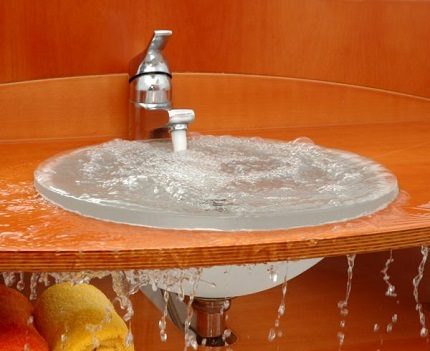
Once you find out exactly where the blockage occurred, you can begin to eliminate it.
Popular folk ways
To eliminate blockage in the pipeline improvised tools are well suited. If the problem is caused by the accumulation of fat, you can try to free the drain from the cork with plain water.
In the case of steel pipes with fatty deposits, boiling water does an excellent job - it needs to be poured for 20 minutes. For plumbing, hot water is used, but not more than 70 ° C.
Check whether the problem is fixed or not will help start the water under high pressure.
Method number 1 - baking soda
Sodium carbonate or baking soda familiar to all of us will help to cope with a plug of fatty deposits in pipes. It is better if it will be domestic production, since imported analogues are not very efficient.
First you need to pour 200 g of baking soda into the drain hole. Then add 200 ml of vinegar and close the hole tightly. The reaction between the substances will effectively dissolve the fat, eliminating the blockage. After waiting 10-15 minutes, open the hot water under high pressure for a couple of minutes.
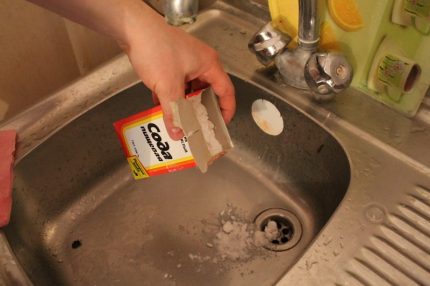
This method is effective only in cases of "fresh" blockages. If they are already old, then you will have to use more caustic substances.
Method number 2 - caustic soda
In the fight against long-standing or severe pollution, you can use a more caustic remedy - caustic soda, which can be purchased at any hardware hypermarket.
Take a large metal bucket and put 2-3 kg of caustic soda into it with a plastic scoop. Fill substance with 12 liters of cold water. Stir the component for 30 minutes. Act as carefully as possible so that the solution does not get on the skin. It is necessary that the soda is completely dissolved.
Put the bucket on fire, and heat the mixture to 70 ° C. It is important not to overexpose the solution, otherwise it will lose its effectiveness. In addition, very hot liquids can damage pipes.
Slowly fill half of the composition into the sewer and leave for 2 hours. After the indicated time, pour out the remaining mixture and wait 2 hours again. Rinse the sewer pipes liberally with hot running water.
According to the hostesses in the reviews, caustic soda can cope even with strong blockages the first time. The main thing is to adhere to the proportions and wait for the specified time.

More gentle is caustic gel soda. You can also buy it at hardware stores. The cost of gel soda is slightly higher than usual. And in terms of efficiency, they are practically not inferior to each other.
In order to clean the pipeline, take 100 ml of the component, fill it in the hole, and then add 250 ml of hot water. Wait 2 hours, then rinse the pipes thoroughly with hot running water.
Method number 3 - soda, vinegar and chlorine
Vinegar, soda and chlorine will help to cope with severe pollution. All these substances are likely to be found in the bins of any hostess. The last component is not completely harmless to humans, however, it can effectively cope not only with fatty, but also with lime deposits in the water supply.
First of all, remove water from the sink - excess fluid will reduce the effectiveness of the product. Pour 50 g of soda ash and baking soda into the sink. After 30 minutes, pour 150 ml of vinegar and 150 ml of chlorine there.
Be sure to tightly plug the hole to avoid the appearance of acrid and unpleasant odors in the room. After 30 minutes, open warm water and leave it for 40 minutes.
Method number 4 - coarse salt
If a problem occurs in cast iron pipesthen coarse salt and boiling water will help to cope with it. As a "reagent" you can use vinegar essence, but finding it now is quite problematic.
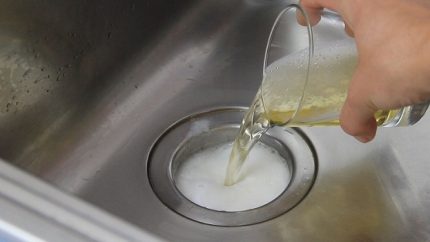
To begin with, pour 300 g of large sodium chloride into the drain hole. Add 2 liters of boiling water, 100 ml of 70% vinegar, wait 30 minutes and check the result. Do not worry, if you could not manage the first time, you may have to repeat the procedure several times.
Method number 5 - citric acid
Citric acid copes with lime deposits in pipes. She has repeatedly proved her effectiveness. Mistresses note that the tool allows you to cope with the problem even the first time.
First, pour 100 g of citric acid into the drain hole and pour 250 ml of boiling water over the component, and after 20 minutes, open the hot water.
Instead of citric acid, juice of fresh lemons is suitable. Take it in an amount of 100 ml and pour inside the drain. Leave the product for 1 hour, and then let running water flow.
We also recommend that you read our other article, where we talked in detail about how to clean the toilet of limescale. Read more - read Further.
Method number 6 - salt and soda
Use soda and salt to dissolve the fat plug. Take 300 g of each component, mix and dissolve in hot water - you need to get a highly concentrated solution. It is important to achieve complete dissolution of the components.
Pour the mixture into the drain and wait 15 minutes and briefly turn on the water. If the first time you can’t cope with the problem, repeat the procedure. Only this time, add 15-20 ml of vinegar to the finished composition.
Method number 7 - tablets "Alka-Seltzer»
Instead of soda and salt, you can use the effervescent tablets "Alka-Seltzer". They have repeatedly proven their effectiveness.
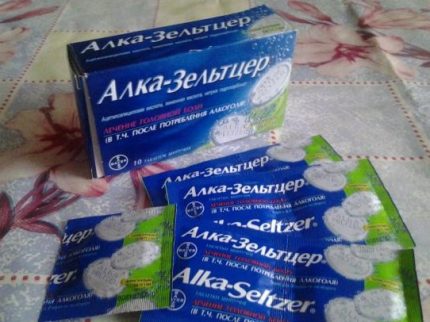
To remove the cork, you need to take 2 tablets and place in the drain. Pour the tablets with a glass of vinegar and 50 ml of water. Leave it for a couple of minutes, and then rinse with hot water.
Please note that the tablets "Alka-Seltzer»Sold in ordinary pharmacies. They are affordable and over-the-counter.
Method number 8 - washing powder
In the fight against light pollution and for the prevention of blockages, housewives use washing powder. Agree, it will definitely be found in every house.
To combat blockages, it is important to use granular, rather than liquid, washing powder. Only the first option will help to solve the problem effectively.
It is taken in the amount of 2 scoops and poured into the drain. Next, hot running water is turned on for 5 minutes. After this time, the cork should disappear.
Let's turn to chemicals
If there is no time for experiments with folk remedies, then you can use specialized mixtures that are sold in any supermarket, in the department of household chemicals. They are affordable and highly efficient.

Let us dwell on the most popular chemicals used by housewives to eliminate blockages.
Mole - An affordable solution that is well suited to combat household pollution. Pour 200-250 g into the drain and leave for 2 hours. For old traffic jams, you can leave the liquid overnight.
After the specified time, apply water with a strong pressure. If the plug cannot be removed immediately, use the tool again.
Debouche - universal fluid to eliminate mechanical and fatty blockages. Scheme of application: pour 500 ml of liquid into the drain and leave for 3 hours.
With severe pollution, twice as much is used, and the validity period increases to 10-12 hours. After useDebouche Be sure to flush the pipes with plenty of water.
Pothan - a solution to eliminate all types of blockages in cast iron and plastic pipes. First, you need to lower the water level in the drain by 5 cm. Next, pour 100 ml of the product and 100 ml of boiling water. After 5 minutes, warm water is fed into the drain.
Mister Muscle - A popular powder for eliminating fatty plugs. It penetrates the most difficult places and, due to its special composition, removes not only blockage, but also harmful bacteria and unpleasant odors. According to the manufacturer, Mr. Muscle copes with the problem in just 5-10 minutes.

Flup - a cleaner that dissolves fat, organic and hair plugs. The tool is quite caustic, so when working with it, you must definitely arm yourself with protective clothing, a respirator and rubber gloves.
AddingFlup into the drain hole, it is important to avoid getting it on the plumbing, as well as on exposed parts of the body or clothing. The product is poured with hot water and left for the time specified in the instructions. Then the drain is washed extensively with cold water.
Tyreth Turbo - universal solvent, produced in the form of a gel and granules. In the first case, it is poured into the drain and left for 5-10 minutes. Using the granular version, it is first poured into the drain, and then 500 ml of hot water is added and left for at least 10 minutes.
Use the last tool longer than the time specified in the instructions is prohibited. The active substances that make up its composition can cause destruction of the pipe walls.
There is an article on our website where we examined in detail the best chemicals for cleaning sewer pipes. Read more - read Further.
Radical solutions to the problem
When the blockage cannot be eliminated with the help of folk remedies and chemicals, it is worth trying to deal with it using mechanical methods.
Option number 1 - a vacuum cleaner
You can use a vacuum cleaner to deal with clogging. However, the device must have a functionblowing. If you are the owner of such a technique, first wrap the end of the device’s hose with a loose rag. It is very important to fix it well.
Lean the hose firmly against the drain hole and turn on the vacuum cleaner to the maximum. A powerful stream of air will push out the plug formed in the pipe.

Using a vacuum cleaner is effective when the problem is not more than 1 meter from the drain hole.
Option number 2 - plunger
To bleed the drain, use a plunger, which can be manual or mechanical. This device is likely to be found in every home. It helps to create strong pressure inside the pipe, due to which the blockage breaks or is pumped deeper.
During pumping, move the plunger back and forth without taking the bowl from the drain. Take several approaches, and then remove the plunger and evaluate the effectiveness of the work. If the fluid comes off slowly, you have to repeat it all over again.
Before working with a plunger, it is advisable to lubricate its edges with solid oil or petroleum jelly. Then a more dense contact with the sink will be provided.
Option number 3 - plumbing cable
When a cork formed on the bends of pipes or far in communications, a plumbing cable is used. With its help, you can hook and pull out the blockage or clear it.
The process of cleaning the pipes with a cable begins with the dismantling of the siphon. Do not try to work the cable straight through the plumbing drain hole. Only by removing the siphon, you will get free access to the sewer.
After installing the cable in the pipe, start screwing it clockwise, trying to slowly push forward. Act smoothly and gradually, avoiding sudden movements.

If you encounter resistance, rotate the device until it continues to move. After that, you can put the siphon in place and flush the system.
Not everyone has a plumbing cable, but, if desired, you can buy it at any plumbing store.
And about the types of plumbing cables for cleaning the sewer, read this stuff.
In addition, you can make this device yourself from a plastic bottle and improvised materials.
The instruction is as follows:
- Tape the bottle from top to bottom with strips of adhesive tape so that a spiral forms.
- Draw along the border of the duct tape with a color marker.
- Cut the bottle according to the marks.
- Be sure to leave the bottom - it will act as a handle.
- Make small notches along the resulting spiral.
- Insert a homemade cable into the drain and push it, slowly holding the "handle". Due to notches, garbage will cling to it, thus it will be possible to overcome the cork.
This device is only suitable for plugs that are not too far from the siphon.
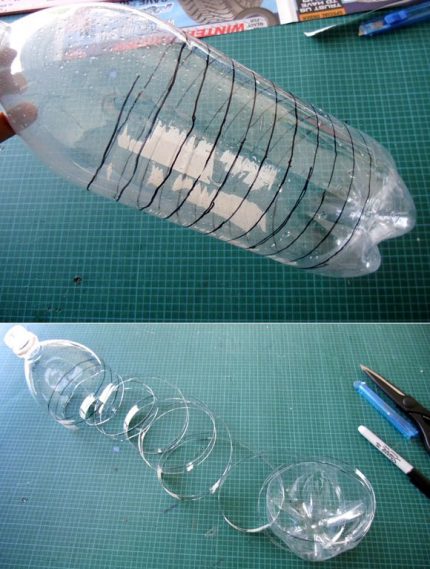
For blockages at great depths usedsteel wire with a diameter of 5-6 mm. One end is crocheted.
Option number 4 - disassembly and cleaning of the siphon
As was said at the beginning of the article, in 90% of cases, the water does not go further than the sink due to clogging of the siphon.
The procedure for cleaning it is as follows:
- Spread an unnecessary rag on the floor that absorbs water well. It should be directly under the siphon.
- Place a basin under the sink into which the fluid will merge.
- Unscrew the lock nut securing the siphon tube.
- Remove the siphon. Remove all impurities from it (this is convenient to do with a brush), and then rinse thoroughly under running water.
- Pour a solution based on soda and vinegar into a pipe connected to the sewer. When the reaction is complete, pour another 150 ml of vinegar. Repeat this process several times.
- After 15-20 minutes, pour a few liters of hot water into the pipe and wait 5 minutes.
- Replace the siphon and tighten the lock nut.
As a rule, if you follow the instructions given, you will be able to cope with the blockage the first time.
Prevention of blockages
The most common cause of sewage blockage is fat. It gradually accumulates on the walls of the pipes after washing the dishes, especially if you wash it in cold water or use a detergent that is not of high quality.
The best prevention is installationgrease catcher. It is a small structure with two sections, which is attached to the sink. The principle of its operation is that first, water with particles of contaminants and fat enters the first section of the device, where the liquid is cleaned of debris.
In the second section of the design, the water is cleaned of fat and only after that it enters the sewer pipes, which ensureshassle-free water supply operation.
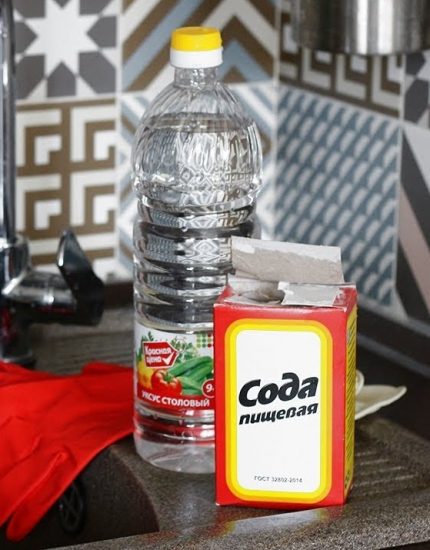
Prevention of blockages also involves a number of other measures.Before washing, remove particles of adhering food from the dishes. It is important to avoid food debris entering the sewers. Sticking to the pipes, they later become the cause of all problems with sewage.
Also, do not pour the fat remaining after cooking into the sewer - it must be disposed of separately, otherwise problems with blockages cannot be avoided.
Make it your own rule not to throw hair from a comb, paper, or various objects into the toilet. Additionally, install a special protective net on the drain.
Once every 2 weeks, turn on hot water with full pressure for 1-2 hours. Also, regularly use a plunger.
At least 1 time per month, use one of the specialized products that are sold in household chemistry departments. This simple prevention will help to forget about traffic jams in pipes.
Conclusions and useful video on the topic
Modern ways to deal with blockages in pipes:
The main types of sewer cleaning at home:
Do-it-yourself elimination of clogging is possible using different methods - it all depends on what exactly caused the problem, at what distance from the drain the plug is.
In any case, everyone can cope with the blockage independently. In the future, preventive measures should be taken to avoid the recurrence of such a problem.
Perhaps you know other effective ways to eliminate clogging in the pipes? Please tell our readers about them. Leave your comments in the box below.

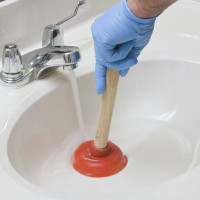 How to clean the sewer pipe at home from clogging: solutions + prevention tips
How to clean the sewer pipe at home from clogging: solutions + prevention tips 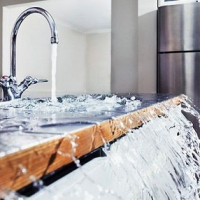 How to clean sewer pipes in a private house: varieties of blockages and methods of cleaning
How to clean sewer pipes in a private house: varieties of blockages and methods of cleaning  Drainage in a private house: device methods, schemes + main stages of construction
Drainage in a private house: device methods, schemes + main stages of construction  Reinforced concrete rings for wells: types, marking, production nuances + the best offers on the market
Reinforced concrete rings for wells: types, marking, production nuances + the best offers on the market  How much does it cost to connect gas to a private house: the price of organizing gas supply
How much does it cost to connect gas to a private house: the price of organizing gas supply  The best washing machines with dryer: model rating and customer tips
The best washing machines with dryer: model rating and customer tips  What is the color temperature of light and the nuances of choosing the temperature of the lamps to suit your needs
What is the color temperature of light and the nuances of choosing the temperature of the lamps to suit your needs  Replacement of a geyser in an apartment: replacement paperwork + basic norms and requirements
Replacement of a geyser in an apartment: replacement paperwork + basic norms and requirements
In one way or another, every person is faced with a blockage in pipes, despite the fact that we are trying to carefully use plumbing. The plunger cannot always cope with the problem that has arisen. For myself, I determined the best remedy - “Mole”. It completely restores the throughput of the pipeline. And besides that, it kills germs. The only thing you should not forget about the correct application, since “Mole” contains caustic alkali.
All these soda vinegar do not please me. They can damage the coating of pipes. It is better to use special plumbing solutions. I used to buy powder, which you fall asleep in the drain, pour boiling water and leave it overnight, but then I found out that it corrodes the surfaces and switched to liquid means.
But these are all mild methods, they work only if used regularly, at least once a month. And with a serious blockage I use a cable.
Well what are you talking about. You write that soda corrodes and then “use liquid products”. All of these special tools for clearing blockages are aggressive chemicals. And they do much more harm to pipes, compared to soda and other “folk” methods. Another thing is that you do not fill them every day, so this harm will be minimal and will not lead to leaks.
I tried many different folk methods and came to the conclusion that all of them are suitable only for prevention or for very weak blockages. When something more serious, only chemistry saves. If chemistry cannot cope, either a cable or a specialist with hydraulics.
Everything would be fine, but no chemistry will help if there is a blockage in the pipe that is not standing, but lying. If the blockage in the lounger chemistry simply does not get to the place of blockage. As prevention, chemistry helps when there is no blockage.
For many years I have been using my reliable method for cleaning blockages under the sink in the kitchen without the cost of various chemicals and plungers.
He removed the standard siphon and instead installed a plastic corrugated tube (sold in plumbing stores) as shown in the photo. To create a water lock, it is necessary to bend it and fix it with a thin rope.
To eliminate the blockage, turn on the hot water and shake the corrugation several times under the sink. the receiver. In case of severe blockage, you can untie the rope, straighten the corrugation and also shake. The blockage will disappear without a doubt, and you will be happy without any cash costs.